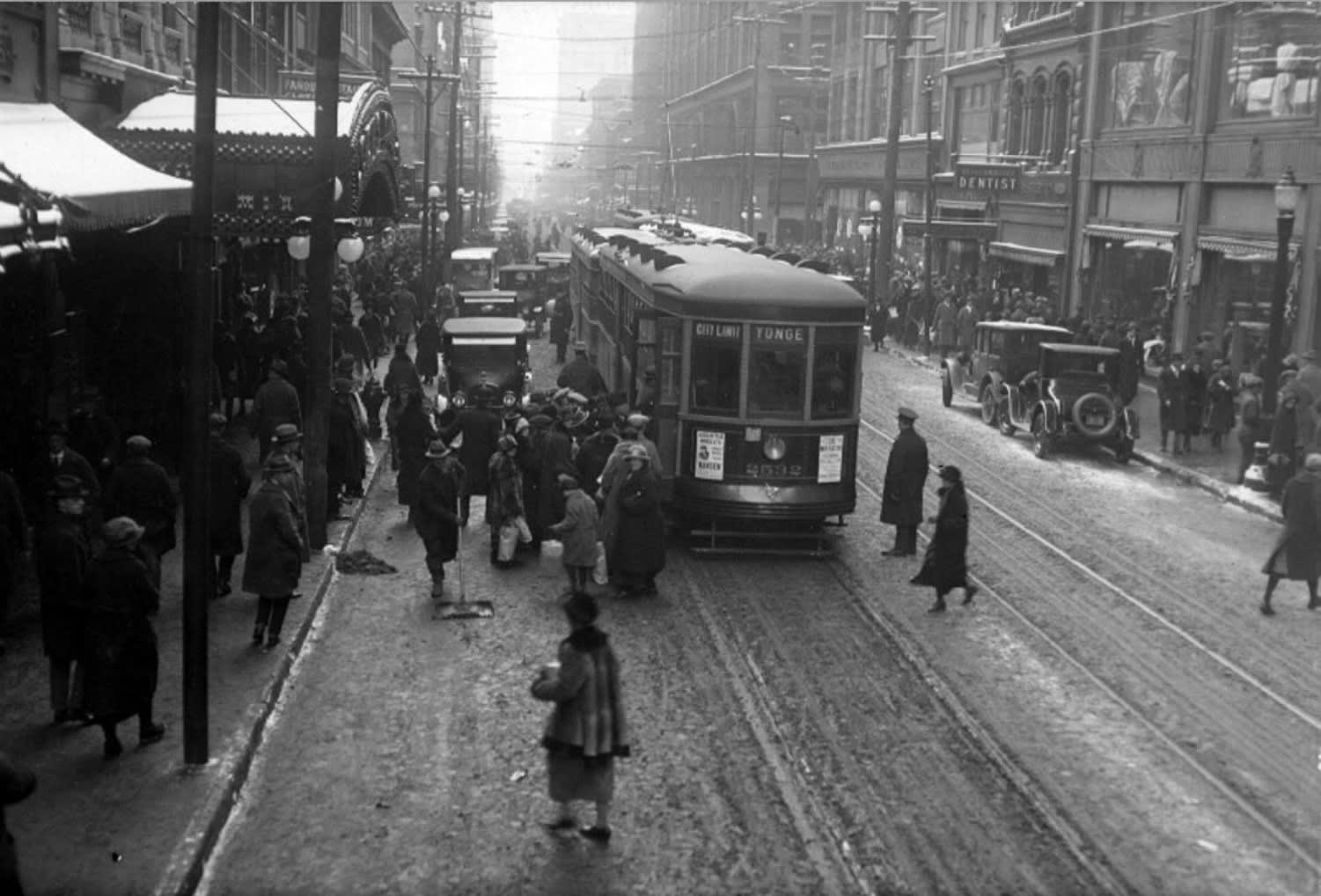Share
The evolution of transit links between York Region and Toronto
Decades of transit progress has paved the way for the Yonge North Subway Extension.
Nov 27, 2024
Building the future of public transportation means understanding how connections have evolved over time. Toronto and York Region share a long and storied history of transit connections that have been shaped by innovation and increasing demand.
This shared story of progress has brought us to the Yonge North Subway Extension, which will extend TTC Line 1 subway service approximately eight kilometres north to create more seamless transit connections in communities in north Toronto and York Region. To truly appreciate what’s next, let’s take a look at some of the important transit milestones that brought us here.
Horse before the cart
Williams Omnibus shown in front of Red Lion Hotel, Yonge Street. (Owen Staples painting, courtesy of Toronto Public Library)
In the late 1700s, transportation options in what was then known as the Town of York – what we now call Toronto – were extremely limited. Wealthy residents could travel by horseback or hire private stagecoaches, but no publicly accessible services were available in Toronto, or in most parts of the world.
It wasn’t until the 1800s that the idea of shared public transportation took root in Britain with the development of the omnibus (a Latin word meaning “for all,” and the reason we call them buses). These horse-drawn carriages carried multiple passengers, taking them along designated routes for an affordable price.
The idea exploded across Europe, and in 1849, cabinetmaker and undertaker H. Burt Williams launched the very first public omnibus service in Toronto out of his shop at 140 Yonge Street. But this wasn’t just a first for the city—it was also the very first service of its kind in all of Canada.
Horse-drawn cars traveling on metal rails were once the fastest and easiest way to travel on Yonge Street. (City of Toronto Archives)
Williams’ omnibus service was such a success, he would amass a larger fleet and operate the service every few minutes. But over time, they began to feel old fashioned. The omnibus would eventually be replaced by another development in equine-powered transit: the horse-car.
These carriages were essentially horse-drawn streetcars that rode along metal rails, providing a faster and smoother ride than the wagon-wheeled omnibus. Tracks were laid on Yonge St. and in 1861, a new fleet of horse-cars was dubbed the Yonge Streetcar Line. This became the very first streetcar line in Canada, and as technology advanced and demand grew, it would rapidly improve to meet the public’s transit needs.
An electric age
Built in 1922, Glen Echo terminal allowed commuters to transfer from Yonge streetcars to other transit services. (courtesy of Toronto Public Library)
With the city’s population booming, more rail infrastructure was installed to meet the increasing demand. Advances in technology lead to the electrification of streetcars, allowing for more reliable service that could expand beyond then-city limits. In 1897, Toronto’s Metropolitan Street Railway was extended north to Richmond Hill, establishing an early north-south transit spine between Toronto and what was then York County. The line helped to spur growth and encouraged economic activity in communities along the route.
Early transit hubs like Glen Echo terminal, located north of Yonge and Lawrence, became important transfer points, allowing commuters to transfer from streetcars to busses and trolley lines that served what is now York Region, Richmond Hill and beyond. These connections played an important role as Toronto and its surrounding areas grew and laid the groundwork for today’s modern transit network.
The subway era
Canada’s very first subway, then known as the Yonge Subway, took travelers between Union Station and Eglinton, with ten more stops in between. (City of Toronto Archives)
Though underground rapid transit had been in existence in cities like London and New York since the late 1800s, it would take over 90 years for a similar system to arrive in Canada.
That milestone would arrive in 1954, when the nation’s very first subway system officially opened, running on a mix of underground and above-ground tracks. Operated by the newly created Toronto Transit Commission (TTC), the inaugural Yonge subway line (now part of Line 1) reduced traffic congestion, improved commute times, and supported new places to live and work along its route, which ran between Union and Eglinton stations. Further expansion work in the 1970s would bring the subway to Finch Station.
The next chapter
The Yonge North Subway Extension will expand Line 1 service from Finch Station to Richmond Hill. (Metrolinx image)
The Yonge North Subway Extension is set to take transit connections between York Region and Toronto even further. The extension will bring the TTC’s Line 1 subway nearly eight kilometres north from Finch Station, adding five new stops to serve communities in North York, Vaughan, Markham and Richmond Hill.
With fast, convenient connections to local and regional transit lines, the extension will make it easier for people across York Region and Toronto to reach destinations all over the region. The project will also make travel more affordable, especially with One Fare offering free transfers between TTC, GO and York Region Transit.
Progress on the Yonge North Subway Extension is already underway. Early upgrades at Finch Station are complete and utilities are being relocated along the route to make sure future construction can move forward smoothly. Metrolinx is also in the process of searching for a construction partner to design and build the new tunnels, which is an important part of bringing the project to life.
by Shane Kalicharan Metrolinx editorial content advisor
